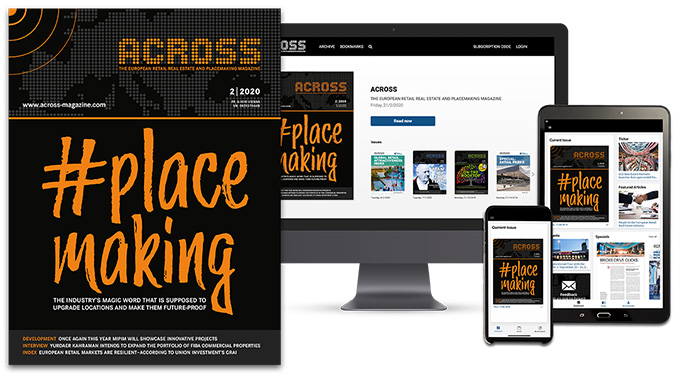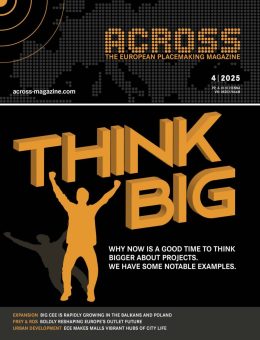Written by
Peter Sempelmann
When Paddy Gamble, Head of Data & Analytics at Portland Design, talks about the future of retail real estate, he rarely begins with footfall or sales. Instead, he starts with something much more fundamental: how people behave and the value those behaviors create – both in the real world and online.
The challenge, Gamble says, is that many of the industry’s traditional metrics reflect only a fraction of the value a place generates. They measure what people buy, but not what they feel. They measure visits, but not the relationships formed or the digital behaviors triggered by those encounters. And they certainly don’t capture the emotional responses that shape loyalty and perception long after a visitor has left the building.
“Footfall and sales will always matter,” Gamble explains, “but they no longer capture the full value a place can create.” Today, the physical world and the digital world are inseparable. When someone visits a flagship store, the spillover effect on online behavior often outlasts – and outweighs – the in-store transaction. A positive experience may lead to a lifetime of loyalty, while a negative one can quickly ripple out to thousands through social media.
This is why Portland Design has built an evidence-based methodology that blends visitation analytics, spending behavior, digital engagement, and emotional sentiment. The result is a multidimensional understanding of value – one that aligns much more closely with how people interact with places.
The Shift from Footfall to Full-Spectrum Value
For decades, the retail property industry operated on a simple premise: more visitors meant more sales, and more sales meant more rent. It was a neat, linear model that made sense in a world where the majority of customer journeys happened inside the store.
But that world is gone.
A visit to a shopping center may end in a transaction later online. A brand activation may generate minimal direct sales but enormous digital reach. Public realm improvement may create excitement, pride, and positivity that shapes perception far beyond the immediate area.
Traditional metrics capture only the transactional moment. Gamble’s work focuses on everything around that moment – the motivations before the visit, the experience during it, and the behaviors that follow. “If we want to understand performance properly,” he says, “we must understand both the physical and the digital worlds, and how they influence each other.”
Mobile-location data has become one of the most powerful tools for understanding these dynamics. It provides not just counts, but patterns: where people come from, how often they return, and how long they stay. Two destinations may show identical footfall growth, yet their underlying value could be completely different. One may be attracting new visitors; the other may simply rely on the same loyal base returning more frequently.
“We must understand how the physical and the digital world influence each other.”
Paddy Gamble
Portland Design
Transaction data reveals another dimension. Spending patterns show which categories benefit, how visitors move through a space, and whether certain populations – tourists, locals, luxury shoppers – behave differently. Combining visitation and spending provides a much clearer picture of economic performance.
But the most radical shift comes from analyzing emotional engagement.
Social media posts – photos, captions, comments – represent raw, unfiltered, real-time feedback. They reveal not just what people did in a place, but how they felt about it. Was it joyful? Disappointing? Memorable? Shareable?
This emotional dimension, Gamble argues, is a major source of hidden value – and is often one of the strongest predictors of future behavior.
The Oxford Street Experiment: A Case Study in Hidden Value
In 2025, Oxford Street hosted a one-day pedestrianization trial – a glimpse into what a reimagined London West End could look like. For many stakeholders, the question was simple: would it work?
The trial presented a rare opportunity: real behavior, in a real environment, with real people. Portland Design analyzed the reported sales and footfall data and layered on social media data that showed digital engagement and sentiment.
The physical numbers alone were impressive:
• footfall up around 45% week-on-week
• about 70% of retailers reporting significantly higher sales
Yet the most compelling story emerged online.
Across social platforms, posts related to the pedestrianization reached an estimated 5.3 million people – far beyond the number physically present. The tone was overwhelmingly positive, filled with nostalgia, excitement, and enthusiasm for a more pedestrian-friendly future.
“We must understand how the physical and the digital world influence each other.”
Paddy Gamble
Portland Design
If that level of exposure had been bought through paid media, it would have cost roughly £180,000.
In a single day, a change to the public realm created not only economic uplift but also massive media value – value that traditional KPIs would never have captured.
“This is what we mean when we talk about hidden value,” Gamble says. “The physical environment can trigger digital ripples that reach far beyond the location itself.”
Why Emotional Data is Now Essential
Collecting emotional data has always been possible through surveys, but surveys capture only what people are willing to articulate – and often only after the fact. Social media provides a much more dynamic dataset. People post spontaneously, visually, and emotionally. AI-powered sentiment analysis makes it possible to interpret this at scale.
But AI doesn’t “understand” emotions on its own. It needs context. Gamble emphasizes that AI is a tool – not the solution. It helps filter noise, categorize behavior, and surface patterns, but human insight is required to interpret what those patterns mean in the context of a place.
By geofencing a location and analyzing posts within specific time frames, Portland can precisely map emotional response to physical experience. When combined with footfall and sales, this reveals a holistic picture of value creation: economic, experiential, and digital.
Places as Media Platforms
This evolving understanding of value leads to a profound industry shift: physical places are no longer just trading environments – they are becoming media platforms.
A brand pop-up may attract a modest number of in-person shoppers yet generate millions of online impressions through social sharing. A visually striking store fit-out may become an Instagram backdrop. A well-designed public space may inspire content creators and travel bloggers.
This reframes the purpose of physical retail.
For brands, the store is not only a place to sell; it is a place to broadcast – a stage for storytelling.
For landlords, the shopping center or high street becomes a channel for brand exposure, amplification, and customer acquisition. A great activation is not just an occupier’s success; it is a destination’s success. And that has direct implications for leasing
Rethinking Commercial Models
If an occupier generates enormous digital value, drives footfall to adjacent stores, or elevates the identity of a destination, should they be assessed solely on direct sales?
Gamble argues that leasing models must evolve to reflect the multidimensional value that today’s occupiers create, and that different models will naturally suit different occupiers and different places – what matters is selecting the model that best aligns with the role, purpose, and value creation of the space.
That doesn’t mean abandoning turnover rent; it means expanding the toolkit to include metrics such as
- visitor engagement levels
- dwell time improvements
- the digital halo effect
- social sentiment
- brand alignment
- and community benefit.
These more flexible, place-appropriate models are far more reflective of real value creation, and increasingly they provide the confidence both landlords and brands need to pursue innovative uses of space.
From Analysis to Prediction
Each activation, redevelopment, or public realm improvement adds more evidence to the industry’s collective understanding of what drives value. Over time, patterns become clear: certain interventions consistently drive dwell; others reliably generate digital reach; others influence spending.
Gamble says the industry is already moving from analyzing the past to predicting the future. “We’re able to forecast uplifts in visitation, spending, or digital engagement with a high degree of confidence,” he explains. “The evidence base is in the data.”
“The more evidence we gahther, the better decisions we can make.”
Paddy Gamble
Portland Design
AI accelerates this by allowing rapid comparison of many case studies, past performance, and contextual variables. The result is a predictive capability that can inform long-term development plans and investment decisions.
A Future defined by Evidence, not Assumption
The retail property industry is undergoing a quiet revolution. The places we once viewed purely as commercial environments are now recognized as complex ecosystems of behavior, emotion, and digital influence. The transaction is just one piece of the puzzle – important, but nowhere near the whole picture.
By expanding the definition of value, landlords and developers can unlock new creative possibilities and build destinations that resonate more deeply with the people who use them.
In Gamble’s words: “Every activation, every public realm change, every pop-up helps us understand a little more about how places create value. The more evidence we gather, the better decisions we can make.” As retail evolves, the real winners will be those who recognize that the success of a place is not only measured at the till – but also in the hearts, minds, and digital worlds of the people it serves.
“Understanding the Hidden Value of Places”
The Media-Powered High Street: Why Retail Spaces Must Think Like Platforms, Not Properties.
ACROSS: Paddy, at Portland Design your team looks beyond traditional metrics in retail real estate. Why is that necessary today?
Paddy Gamble: Because footfall and sales – while still essential – no longer tell the full story. People interact with places across both physical and digital channels. A visit to a store might not lead to an immediate purchase, but it might inspire someone to buy later online, follow a brand, or share the experience socially. If we only look at transactions, we miss a huge amount of value creation.
ACROSS: What kinds of value are being overlooked?
Gamble: Emotional engagement, digital visibility, and behavioral influence. A great experience can create loyalty and advocacy; a poor one does the opposite. Public realm improvements or brand activations can generate digital reach far beyond the physical audience. These outcomes influence the long-term performance of both brands and destinations, even if they don’t show up at the till that day.
ACROSS: What data do you use to reveal that wider value?
Gamble: We combine three layers. First, visitation – mobile-location data shows where people come from, how often they visit, and how they move through the asset and how long they stay. Second, transaction data – what people spend. Third, emotional and digital data through social listening. AI helps clean, classify, and interpret large volumes of posts so we can understand sentiment and themes. Together, these layers give a full-spectrum view of performance.
“Places now function as media platforms as well as trading environments”
Paddy Gamble
Portland Design
ACROSS: You recently analyzed the Oxford Street pedestrianization trial. What did you learn?
Gamble: The physical uplift was clear – around 45% more footfall and much stronger sales than a typical Sunday were reported. But the digital impact was remarkable: social posts reached an estimated 5.3 million people, with overwhelmingly positive sentiment. The media value of that organic reach was roughly £180,000. It showed how improvements to the public realm can create a powerful digital halo that extends far beyond the street itself.
ACROSS: How should landlords and developers respond to this new understanding of value?
Gamble: By recognizing that places now function as media platforms as well as trading environments. A pop-up might not drive big sales, but it can boost visibility, footfall, and perception. Leasing and development strategies need to reflect these broader forms of value – engagement, dwell, sentiment, digital reach – not just turnover.
ACROSS: Are we getting closer to predicting performance?
Gamble: Yes…. we are already doing this. Every case study gives us more evidence. We can now forecast likely uplifts in footfall, spending, or digital engagement with increasing confidence. AI accelerates the process, but human interpretation remains essential. Evidence, not assumption, is shaping the future of placemaking.
About Paddy Gamble

As the Head of Data & Analytics at Portland Design Paddy Gamble leads the consultancy’s evidence-based approach to understanding how people use and experience places, combining visitation data, spending behavior, emotional sentiment, and AI-driven analysis. He specializes in linking physical experiences with digital behavior to help clients make confident, data-driven decisions in a changing retail landscape.
Contact: paddy@portland-design.com
Learn more from Paddy Gamble:
Future Innovation Day – Preparing for the Next Decade
Paddy Gamble Gamble also leads the “Insight Workshop” during ACROSS’s latest offer, the “Future of Place Innovation Day”, organized in cooperation with the London-based design and strategy consultancy Portland Design through the ACROSS ACADEMY.
The Future Innovation Day is a bespoke workshop for C-level leaders – not a conference. It identifies the key “future-ready drivers” that will shape the next ten years.
The day includes:
- A keynote from Ibrahim Ibrahim on the future of retail and culture.
- A foresight session by Elisa Cecilli on cultural and consumer trends
- Data insights from Paddy Gamble, who demonstrates our AI-powered “digital ethnography” tool mapping social sentiment in any location.
- The day ends with a workshop defining the main opportunities and directions for each business.







